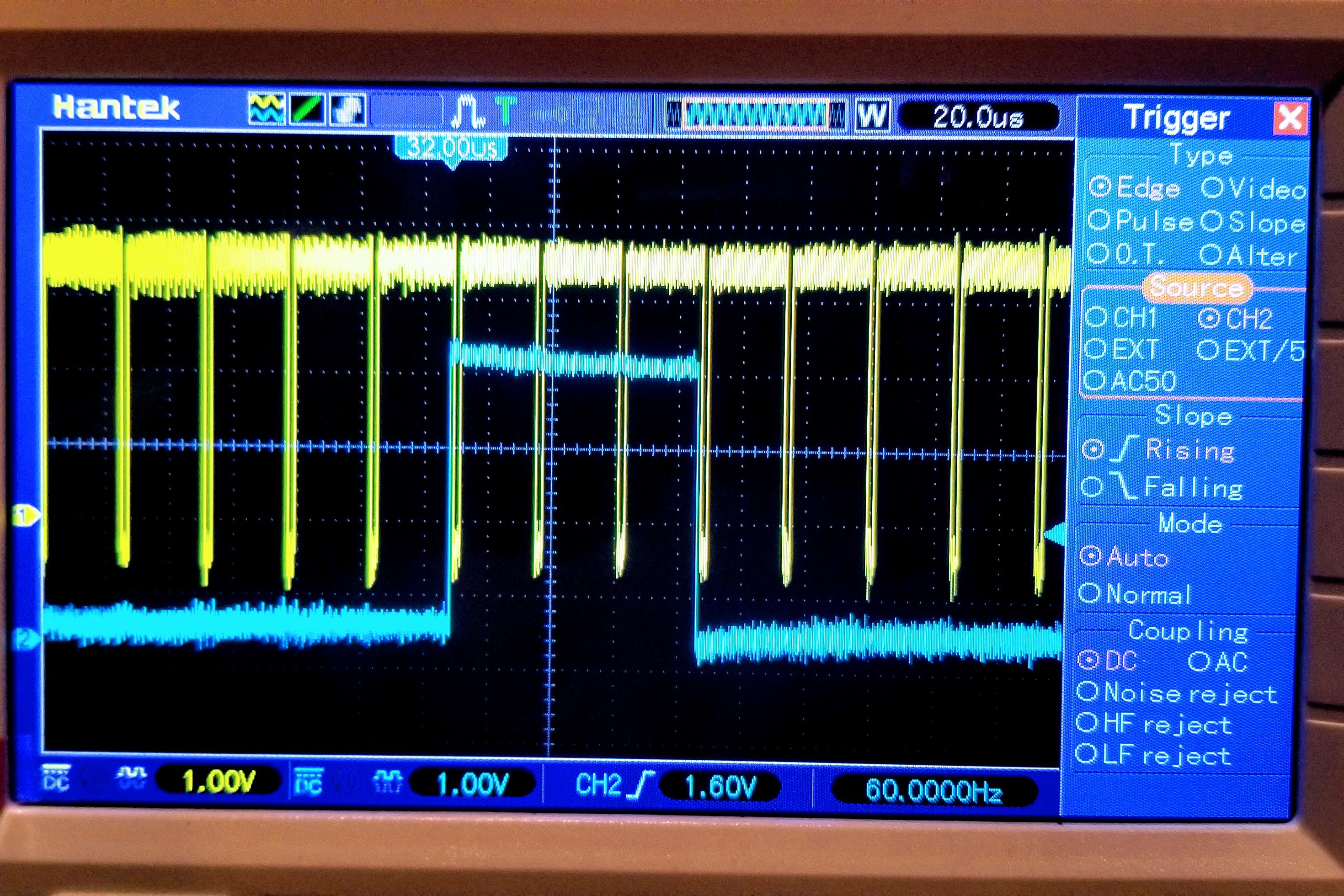The first 5 chips of the GPU were added this weekend. This included the H register (4-bit counters and buffer) and the V and S registers (8-bit flip-flops). Most of the time was taken up with software development for a video timing loop.
The end result was the 38.4 kHz H-sync and 60 Hz V-sync signals. This matches the modified SVGA timing used with the Arduino in earlier testing. The syncs follow the GTF timing spec with a negative H-sync and a positive V-sync signal spanning three H-sync pulses (as seen below).

The actual firmware is highly optimized and uses a custom ALU function to return all the video timing based on a single counter and video-specific modulo function. There is still a lot missing from the ALU with only the basic binary functions like ADD, SUB, AND, and OR available, so a multilayer loop was coded to calculate the timing in real time.
A precise cycle count of 208 is required for each iteration of the video loop regardless of any conditional branching that occurs. This is achieved by adjusting the length of the inner loop (shown first in the listing below). This tight 5-cycle loop is used to burn up the remaining cycles given an initial value loaded into the HL register. The other execution paths are padded with NOPs to be divisible by 5 cycles.
The video timing loop uses four bytes of the zero page:
- 0x1FF20: $BURN - temporary store of burn-down count.
- 0x1FF21: $SCAN - line of text glyph to render (0-7)
- 0x1FF22: $LINE - line of video memory to read (0-79)
- 0x1FF23: $SYNC - mask of the V-blank and V-sync bits combined with the scan to make up S register.
The code is located at the reset vector (0x08000) and consists of 109 bytes. The first condition will increment the scan count when the burn loop expires. The V-sync bit is cleared when the scan count is greater than 3. The second condition is met when the count gets to 8 and results in a reset to the scan count and an increment of the line count. The third condition is met when the line count is greater than 75 and results in setting the V-blank and the V-sync bits, where the latter is only set for the first cycle. The final condition is reached when the line count reaches 80 and both the line count and mask are reset to zero.
The listing is show below where the numbers in square brackets represent the number of cycles. The address and encoding is shown along side the nemonic and a comment per instruction.
[2] 8000: 9420 LD Y, 20
[4] 8002: 0804 MVHLZ ND1 # immediate load of $BURN
[2] 8004: 9510 LD HL, 10
[3] 8006: 582C SUBH D1Z, ND1 # count down to -1
[2] 8008: A606 LDP PC, 06 # 5-cycle loop, [5n - 1] cycles
[2] 800A: 9421 LD Y, 21
[3] 800C: 591F ADDH D1Z, HLD1 # increment $SCAN
[2] 800E: 9423 LD Y, 23
[4] 8010: 1E5E ORHL D1Z, SA # strobe scan with $MASK
[2] 8012: 9421 LD Y, 21
[2] 8014: 9520 LD HL, 20
[3] 8016: 5C2C SUBH D1Z, NA # compare using $SCAN - 2
[2] 8018: 9423 LD Y, 23
[.] 801A: A5DF LDP HL, DF # clear vsync
[3] 801C: B5FF LDN HL, FF # leave vsync
[4] 801E: 184C ANDHL D1Z, ND1 # update $SCAN if S > 3
[2] 8020: 9421 LD Y, 21
[2] 8022: 9570 LD HL, 70
[3] 8024: 5C2C SUBH D1Z, NA # compare using $SCAN - 7
[2] 8026: 951F LD HL, 1F # set burn count to 32 (31 + 1)
[2] 8028: 8080 NOP; NOP
[2] 802A: 80 NOP
[2] 802B: B600 LDN PC, 00 # return [49]
[2] 802D: 95FF LD HL, FF
[4] 802F: 0804 MVHLZ ND1 # immediate load of -1
[2] 8031: 9422 LD Y, 22
[2] 8033: 9510 LD HL, 10
[3] 8035: 5B1E ADDH D1Z, VD1 # increment $LINE
[2] 8037: 954B LD HL, 4B
[4] 8039: 1D2E SUBHL D1Z, EA # compare using $LINE - 75
[2] 803B: 951A LD HL, 1A # set burn count to 27 (26 + 1)
[2] 803D: 8080 NOP; NOP
[1] 803F: 80 NOP
[2] 8040: B600 LDN PC, 00 # return [48+26]
[2] 8042: 954C LD HL, 4C
[4] 8044: 1C2C SUBHL D1Z, NA # compare using $SCAN - 76
[2] 8046: 9423 LD Y, 23
[.] 8048: A510 LDP HL, 10 # vsync off
[3] 804A: B530 LDN HL, 30 # vsync on
[4] 804C: 0804 MVHLZ ND1 # immediate load of $MASK
[2] 804E: 9422 LD Y, 22
[2] 8050: 954F LD HL, 4F # set HL to 79
[4] 8052: 1C2C SUBHL D1Z, EA # compare using $LINE - 79, strobe E
[2] 8054: 9514 LD HL, 14 # set burn count to 21 (20 + 1)
[2] 8056: 8080 NOP; NOP
[2] 8058: 8080 NOP; NOP
[2] 805A: B600 LDN PC, 00 # return [48+25+31]
[2] 805C: 95FF LD HL, FF
[4] 805E: 0806 MVHLZ XD1 # immediate load of -1, strobe X
[2] 8060: 9423 LD Y, 23
[2] 8062: 9500 LD HL, 00
[4] 8064: 0804 MVHLZ ND1 # immediate load of 0
[2] 8066: 9510 LD HL, 10 # set burn count to 17 (16 + 1)
[2] 8068: 8080 NOP; NOP
[1] 806A: 80 NOP
[2] 806B: 9600 LD PC, 00 # return [48+25+30+21]
 Alastair Hewitt
Alastair Hewitt
Discussions
Become a Hackaday.io Member
Create an account to leave a comment. Already have an account? Log In.